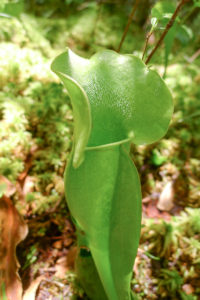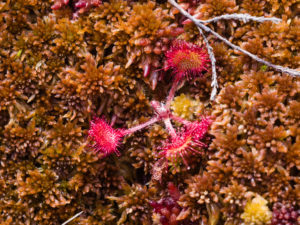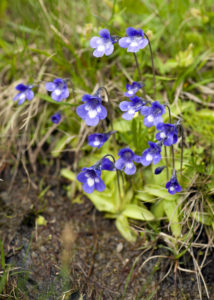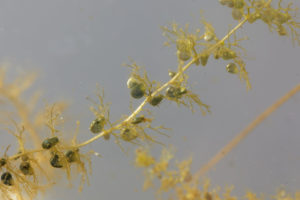
Carnivorous Plants in Minnesota
Learn more about four species from each of the carnivorous plant genera in the state.
Published07/26/2021
You may be familiar with Minnesota’s many plant families, but did you know that some of those plants have got a little bite to them? Tim Whitfeld, Collections Manager at the Bell Museum Herbarium shares more about the carnivorous genera that reside in our state.
With funding from the National Science Foundation and in collaboration with other herbaria around the country, the Bell Museum Herbarium is working on a digitization project focused on 15 plant families that all exhibit various unusual morphological features and life history strategies. One of these strategies is carnivory, plants that eat animals—in this case, small insects. In Minnesota, you can find 14 species of carnivorous plants. Here we feature four species, one from each of the carnivorous plant genera in the state.

Sarracenia purpurea (purple pitcher plant)
This genus was named for Michel Sarrazin de l’Etang (1659-1734), the King’s physician in New France (the French colonies in North America), who sent the first specimens of this plant to Europe. The species name means “purple,” referring to the color the leaves turn later in the growing season. These leaves are modified into pitcher-shaped pitfall traps for catching and digesting small insects. Insects that fall into the pitchers are unable to crawl out because the inner surface is covered with stiff, downward-pointing hairs. The pitchers also hold rainwater and the insects eventually drown and are subsequently digested by the plant. In this way, pitcher plants are able to obtain nitrogen and other nutrients that are in limited supply in their preferred boggy habitats. Where this habitat still exists, pitcher plants are relatively common across the forested parts of Minnesota.

Drosera rotundifolia (round-leaved sundew)
The genus name comes from the Greek “droseros” (dewy), referring to the glistening, sticky droplets on the leaf hairs. The species name means “round-leaved.” This species has an interesting distribution: circumboreal with outlier populations in the high alpine zones on the mountains of New Guinea, in the South Pacific! Like pitcher plants, round-leaved sundews grow in low-nutrient boggy habitats. They can also be found in moist, sandy soil in some parts of their range. They trap small insects on the sticky leaves and digest them for nutrients. Like pitcher plants, this species is also common where the appropriate habitat still exists across the forested parts of Minnesota.

Pinguiculas vulgaris (butterwort)
The genus name comes from the latin pinguis, meaning “fat” referring to the glistening, slightly succulent leaves. The species name vulgaris means “common,” which is not a good description of the plant in Minnesota, where this species is only known from scattered populations on the rocky shoreline of Lake Superior. Globally, the species is more abundant across northern latitudes. Although not closely related to the sundews, butterwort has a similar strategy for trapping insects. It has sticky hairs on the upper side of the leaves, which entangle small insects that are subsequently digested for their nutrients.

Utricularia vulgaris (common bladderwort)
The genus name is derived from the latin utriculus, meaning “wine flask,” “leather bottle,” or “bagpipe.” It refers to the unique bladder-like structures attached to the underwater stems and leaves of this and other species in the genus. These bladders are under negative pressure relative to the surrounding water and will open when a tiny passing aquatic invertebrate releases a minute trigger hair. Within a fraction of a second, water and prey are sucked into the bladder, which then closes tight. Just like all the other carnivorous plants on this list, the insect is then digested for nutrients. Common bladderwort is, indeed, common across Minnesota but unless you’re paying special attention to underwater plants, you probably won’t see it unless the bright yellow flowers have appeared above the water’s surface.

